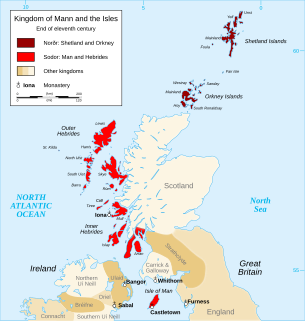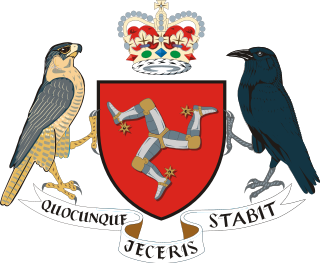
The Isle of Man, also known as Mann, is an island nation and self-governing British Crown Dependency in the Irish Sea between Great Britain and Ireland. The head of state, Queen Elizabeth II, holds the title Lord of Mann and is represented by a Lieutenant Governor. The United Kingdom is responsible for the isle's military defence.

The Isle of Man had become separated from Great Britain and Ireland by 6500 BC. It appears that colonisation took place by sea sometime during the Mesolithic era. The island has been visited by various raiders and trading peoples over the years. After being settled by people from Ireland in the first millennium AD, the Isle of Man was converted to Christianity and then suffered raids by Vikings from Norway. After becoming subject to Norwegian suzerainty as part of the Kingdom of Mann and the Isles, the Isle of Man later became a possession of the Scottish and then the English crowns.

Lists of monarchs in the British Isles are lists of monarchs that have reigned over the various kingdoms and other states that have existed in the British Isles throughout recorded history. They include monarchs of Britain as a whole, and monarchs of states that covered part or whole of what are now England, Ireland, Scotland, Wales and the Isle of Man.

The Kingdom of the Isles consisted of the Isle of Man, the Hebrides and the islands of the Firth of Clyde from the 9th to the 13th centuries AD. The islands were known to the Norse as the Suðreyjar[ˈsuðz̠ˌœyjɑz̠], or "Southern Isles" as distinct from the Norðreyjar[ˈnorðz̠ˌœyjɑz̠] or Northern Isles of Orkney and Shetland. In Scottish Gaelic, the kingdom is known as Rìoghachd nan Eilean. The historical record is incomplete, and the kingdom was not a continuous entity throughout the entire period. The islands concerned are sometimes referred to as the Kingdom of Mann and the Isles, although only some of the later rulers claimed that title. At times the rulers were independent of external control, although for much of the period they had overlords in Norway, Ireland, England, Scotland or Orkney. At times there also appear to have been competing claims for all or parts of the territory. The islands involved have a total land area of over 8,300 square kilometres (3,205 sq mi) and extend for more than 500 kilometres (310 mi) from north to south.

The Crown Dependencies are three island territories in the British Islands that are self-governing possessions of the British Crown: the Bailiwick of Guernsey, the Bailiwick of Jersey, and the Isle of Man. They are not part of the United Kingdom (UK) nor are they British Overseas Territories. They have the status of "territories for which the United Kingdom is responsible", rather than sovereign states. As a result, they are not member states of the Commonwealth of Nations. However, they do have relationships with the Commonwealth and other international organisations, and are members of the British–Irish Council. They have their own teams in the Commonwealth Games.
Olaf or Olav is a Scandinavian given name. It is presumably of Proto-Norse origin, reconstructed as *Anu-laibaz, from anu "ancestor, grand-father" and laibaz "heirloom, descendant". Old English forms are attested as Ǣlāf, Anlāf. The corresponding Old Novgorod dialect form is Uleb. A later English form of the name is Olave.
The English Olaf Guthfrithson is a form of the Old Norse Óláfr Guðfriðarson. An Anglicised form of the Old Norse name is Olaf Godredsson. The Old Irish form of these names is Amlaíb mac Gofraid. These four names may refer to:
The Manx are an ethnic group originating on the Isle of Man in the Irish Sea in northern Europe. Their native culture has significant Norse, Gaelic and English influences. The Manx language descends from Middle Irish.

The following outline is provided as an overview of and topical guide to the Isle of Man:
Guðrøðr is a masculine Old Norse personal name. The name is rendered in Old Irish and Middle Irish as Gofraid or Gofraidh. Anglicised forms of the Old Norse name are Godred, Guthred, and Guthfrith. The name is also Latinised as Godredus.
Gofraid is an Irish masculine given name, arising in the Old Irish and Middle Irish/Middle Gaelic languages, as Gofhraidh, and later partially Anglicised as Goffraid.

The lord of Mann is the lord proprietor and head of state of the Isle of Man. The current lord proprietor and head of state is Elizabeth II. Before 1504 the head of state was known as King of Mann.

The King of Mann was the title taken between 1237 and 1504 by the various rulers, both sovereign and suzerain, over the Kingdom of Mann – the Isle of Man which is located in the Irish Sea, at the centre of the British Isles. Since 1504, the head of state has been known as the Lord of Mann.
Ragnall, Raghnall, Raonall, and Raonull are masculine personal names or given names in several Gaelic languages.

The Crovan dynasty, from the late 11th century to the mid 13th century, was the ruling family of an insular kingdom known variously in secondary sources as the Kingdom of Mann, the Kingdom of the Isles, and the Kingdom of Mann and the Isles. The eponymous founder of the dynasty was Godred Crovan, who appeared from obscurity in the late 11th century, before his takeover of the Isle of Man and Dublin. The dynasty was of Gaelic-Scandinavian origin, descending from a branch of the Uí Ímair, a dominant kindred in the Irish Sea region which first appears on record in the late 9th century.
The former Priory of Douglas was a Cistercian monastery of nuns on the Isle of Man, apparently founded in the reign of Rǫgnvaldr Guðrøðarson, King of the Isles.
This page is based on this
Wikipedia article Text is available under the
CC BY-SA 4.0 license; additional terms may apply.
Images, videos and audio are available under their respective licenses.








